
(image by SORS member Gabi Battaglini)
Always Prepared To Serve
By Fred Stipe, chairman of the board, South Orange Rescue Squad
At South Orange Rescue Squad (SORS), we stay ready. That’s why our motto, which is emblazoned on all our vehicles, is Semper Aptus Muneris, always prepared to serve. That’s really all you need to know.
But there is more to our story.
SORS is a nonprofit squad whose primary mission is to help people in need and engage with members of our community. You’ve likely seen us at UNC Basketball and Football games, where we provide standby emergency services. Perhaps you’ve seen our ambulances alongside local fire trucks—we offer on-site support for firefighters who require medical attention on the scene. Maybe we’ve helped you out when you needed care. We run the overnight shift as part of the county’s 911 system, providing basic life support care, including transport to UNC Hospitals when needed. In 2024, we responded to 1,509 calls.
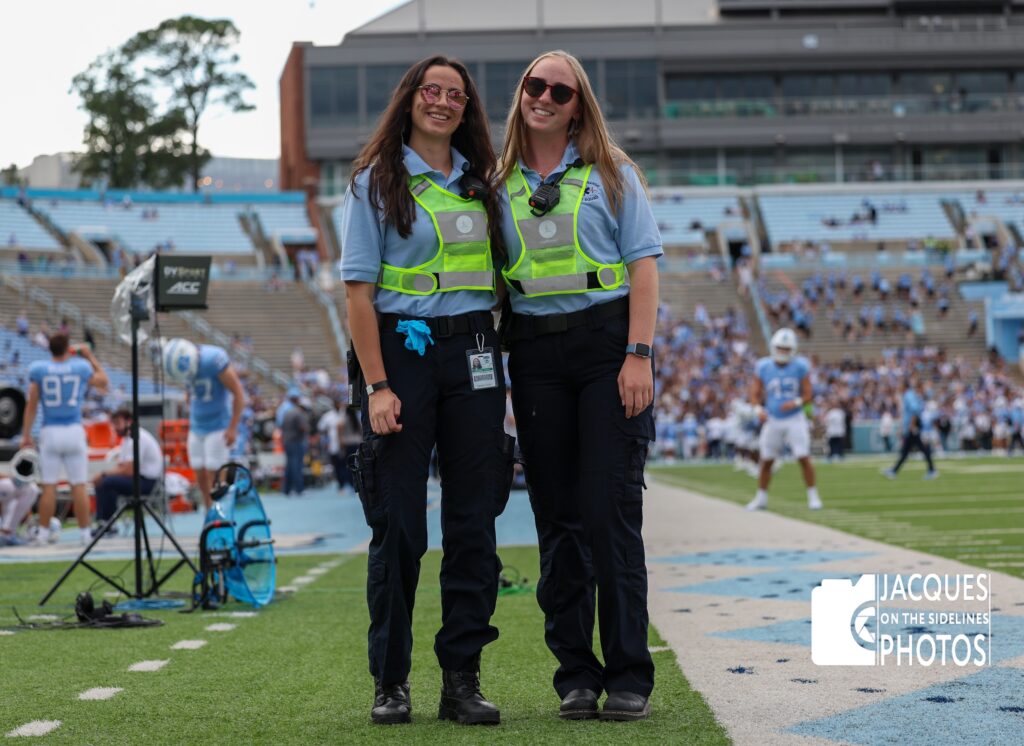
SORS volunteers like Jessica Guemple and Lynnsey Hoos are at every Carolina football home game to provide stand-by emergency medical assistance. Fans can stop by our posts at Gates 2 or 6 for minor medical issues, too. Photo by SORS Board Member Jacques Morin.
Our priorities on every call are unchanging:
- Evaluate people for life-threatening illness or injury
- Provide immediate stabilization
- Determine appropriate interventions
- Ensure safe transport to definitive care
Many of our 75 EMS volunteers are undergraduate and graduate students, all of whom are highly trained and fully certified for emergency response. (EMTs are certified in basic life support and paramedics are certified for advanced life support.)
Volunteer Jessica Guemple racked up 473 hours in the last 12 months while finishing up her senior year at UNC. “The most rewarding aspect of volunteering has to be seeing the positive effect of helping someone else,” notes the Cary native who recently became a SORS lieutenant. “Being able to help someone in a time of need is one of the best things that I can do. My favorite thing about Orange County is the variety of people who make it up. I’ve lived here for four years now and see it as a wonderful place for people in all stages of life and from all different backgrounds.”
Since graduating, Guemple has taken a job with Orange County Emergency Services, making her one of several EMS Division volunteers in emergency response and healthcare careers, including town or county EMTs and firefighters, and practicing nurses and doctors.
A brief history of EMS
There have always been people who responded to health emergencies in their communities. But the modern system we know is barely 60 years old. Let’s take a quick look back at the history of EMS in the U.S. and here in Orange County.
1966—The EMS White Paper “Accidental Death and Disability: The Neglected Disease of Modern Society” is published, prompting the federal standardization of training requirements and minimum standards to serve as an EMT.
1967—Freedom House Ambulance Service is founded in Pittsburgh, one of the first mobile emergency medicine programs in the nation, creating a model for community healthcare and workforce development.
1968—The volunteer-driven Orange County Rescue Squad is established, operating out of a station on South Churton Street in Hillsborough.
1971—A second service, the South Orange Rescue Squad, is established in Carrboro.
1972—Emergency! begins airing, one of the first times professional EMS work is portrayed in-depth on national TV.
1973—The EMS Systems Act passes to provide grant funding to establish EMS systems and codify training requirements.
1974—SORS builds its station on Roberson Street in downtown Carrboro, which we still call home today.
1999—The county’s emergency management department launches an innovative approach to emergency response, the Initial Response Vehicle system, which dispatched paramedics in rapid response cars to medical calls.
2004—SORS re-establishes a strong student and community volunteer-led service to deliver education and technical rescue services in addition to EMS, expanding its service offerings and becoming a workforce development engine.
2010—EMS systems across the country—including SORS via our Community Education division—roll out preventive and non-acute care services to address the causes of frequent EMS calls, provide post-transport and discharge support and other non-traditional EMS services that fall between the cracks of community healthcare systems.
2021—SORS marked 50 years of service to Orange County and beyond.
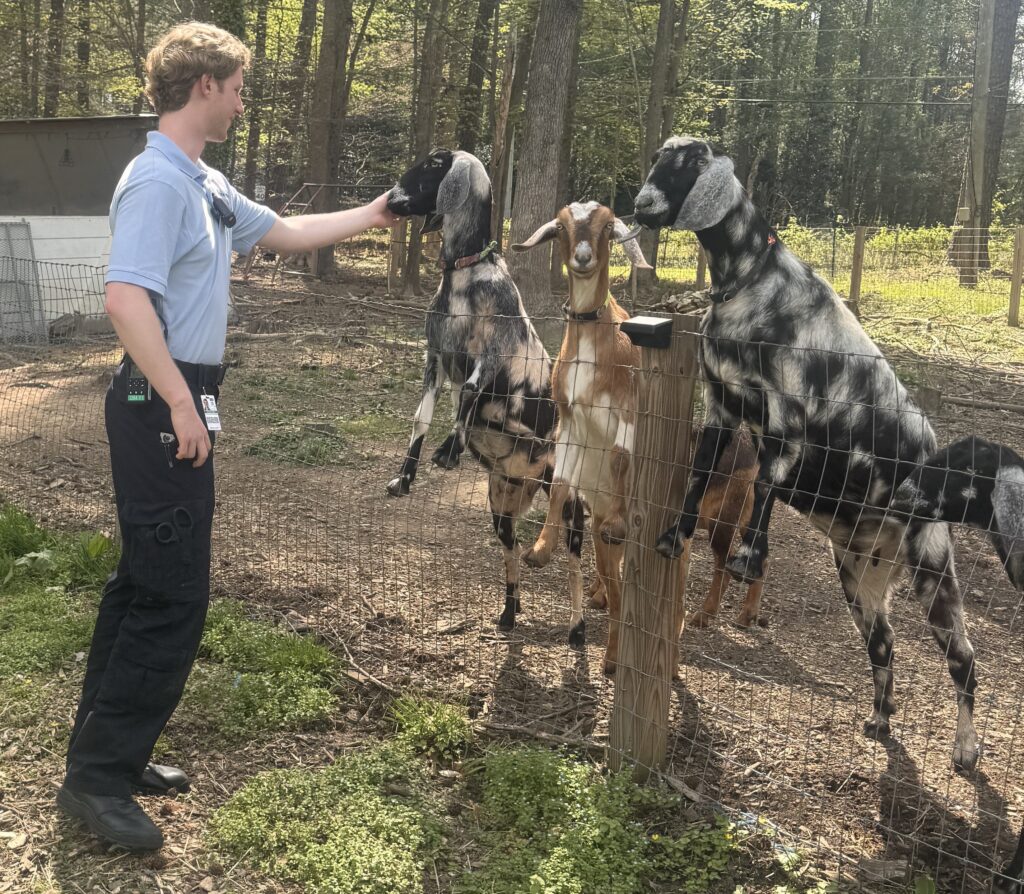
SORS volunteer Connor Marciniak takes a nature break with some curious goats. “I really enjoy the contrast between UNC’s campus and the rural outskirts of Orange County,” he says. Photo courtesy of Connor Marciniak.
Evolving to meet our community’s needs
The skills and scope of practice for EMTs and paramedics have broadened over time, and technology and infrastructure have improved, producing better outcomes for the people we serve. But there are gaps and persistent inequities in the healthcare system that can’t go unaddressed.
EMS crews, including SORS, continue to add capabilities that allow us to extend the reach of hospitals, public health departments and other healthcare providers to help community members who may not be receiving the care and support they need. These additional services include overdose and crisis response.
“Many people think that you can only call 911 just for emergencies like heart attacks or car crashes, but EMS can respond to a wide range of situations like chronic illness flare-ups or even social emergencies, no matter how severe the situation is,” explains volunteer Neil Sud, who wants to pursue a career in medicine. The Cary native has logged 548 hours over the prior 12 months with the squad. “Being able to make someone’s day better and contribute to their medical journey, even just for a brief period of time, is what makes volunteering through SORS the most rewarding.”
We also play a crucial role in helping healthcare providers understand the factors that contributed to each patient’s situation. This includes social determinants of health (SDOH) like economic stability, food sources and community support, access to affordable and quality healthcare, and living conditions. That’s because we take notice of the scene when we arrive and often talk to people there who know our patient and can provide important insights. When we take these folks to the emergency room, our observations help the nurses and doctors get a more complete picture of the person and tailor their care.
“Whether it’s figuring out how we’ll transfer a patient to the ambulance, seeing how we can prevent a patient from falling in the future or simply navigating difficult conversations about someone’s past, it’s a good feeling when I can be sure that I did or said something that made the patient more comfortable in a tough situation,” notes volunteer Connor Marciniak. The Charlotte native charted the most year-to-date volunteer hours on the squad with 625. He recently joined Orange County EMS as an advanced EMT, and is a part-time instructor and tutor at Durham Tech for the EMT and AEMT classes. “I look forward to every shift and I am very appreciative of the privilege to provide patient care.”
Forecasts show demand for healthcare services—including outside of traditional sites of care—continuing over the next five years, and economic uncertainty and climate change exacerbate chronic illness and SDOH. Population growth, estimated at 8% in Orange County population by 2030, creates additional need.
See how you can support our work.
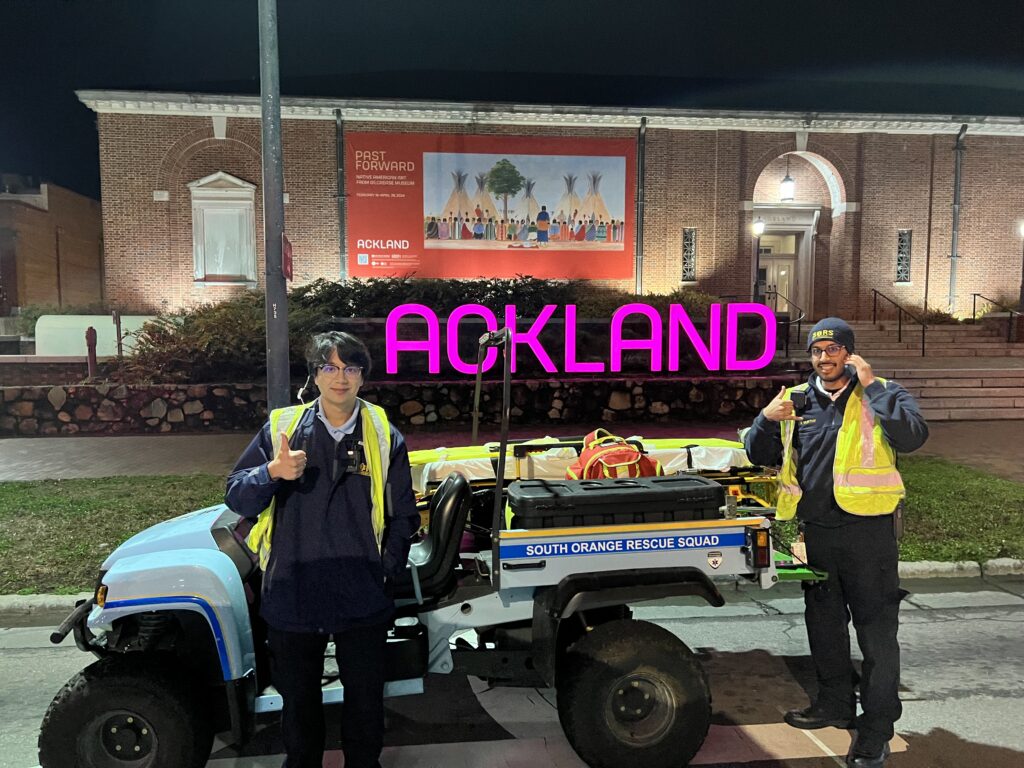
SORS can be a regular presence at community events around the county thanks to volunteers like Neil Sud and Ananth Murthy. Photo courtesy of Neil Sud.
Responding to increasing demand
To help meet the growing need and improve access to quality care, SORS continues to:
- Recruit new members, including collaborating with local schools’ career and technical education programs. Learn about volunteering with SORS.
- Serve as a vital talent pipeline for the County emergency management and response system.
- Train healthcare professionals in basic life support and deliver HeartSaver certification to non-medical professionals who need certification (like camp counselors or educators). Explore our certification trainings.
- Teach free CPR/AED, first aid and stop-the-bleed classes for community members. Schedule a class for your team or your family and friends.
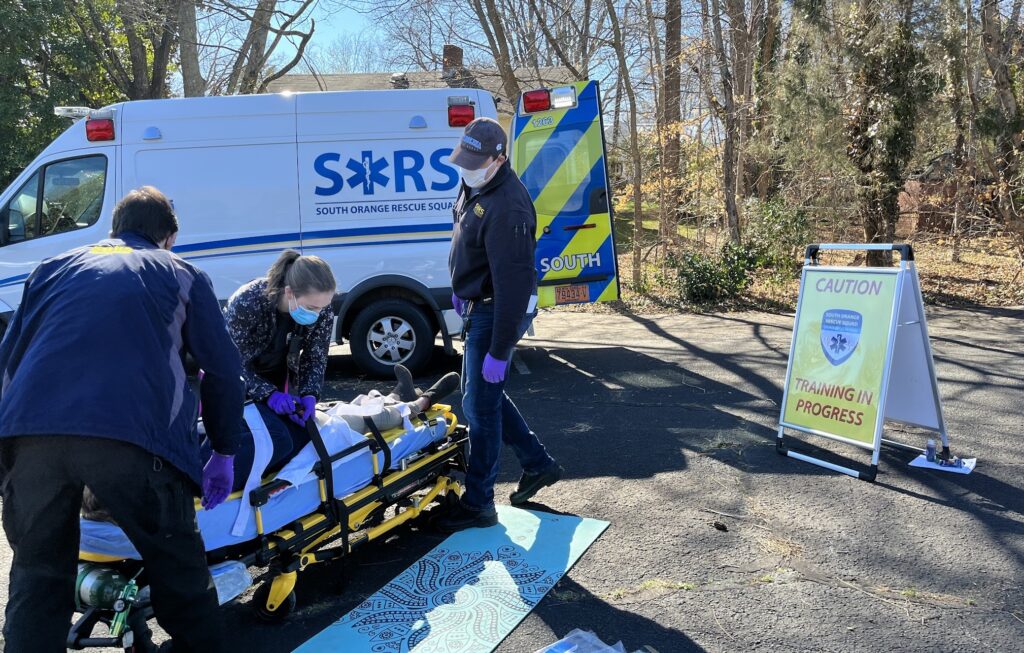
SORS volunteers train regularly in all kinds of conditions to keep their skills sharp and to expand their ability to respond to our community’s changing needs. Photo by SORS member Leyla Ozelkan.
SORS is proud to be an integral part of Orange County’s EMS system, extending high-quality care to more people—as a 100% volunteer-powered organization.
“We’re extremely grateful for all the time, energy and effort all of our volunteers dedicate to South Orange, day in and day out,” says Chief Matthew Mauzy. “Whether at events, working overnight or in training, they dedicate their own free time in service to the community.”
And we’re grateful to the Orange County community, too, for supporting us for more than half a century. Together, we’re making a difference.
Learn more about what it takes to run SORS and how you can help.
Fred Stipe has been a SORS member since 1998 and chairs the organization’s Board.
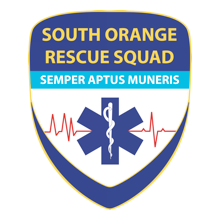 The South Orange Dispatch is a monthly column on Chapelboro by the South Orange Rescue Squad: an all volunteer, 501c3 non-profit providing EMS and technical rescue services in the Carrboro-Chapel Hill area of Orange County since 1971.
The South Orange Dispatch is a monthly column on Chapelboro by the South Orange Rescue Squad: an all volunteer, 501c3 non-profit providing EMS and technical rescue services in the Carrboro-Chapel Hill area of Orange County since 1971.

